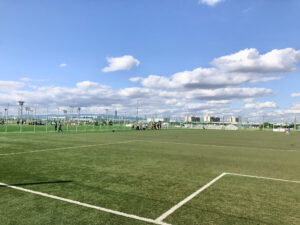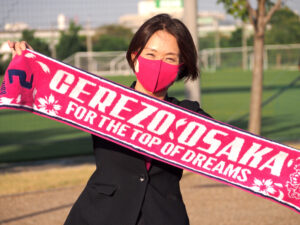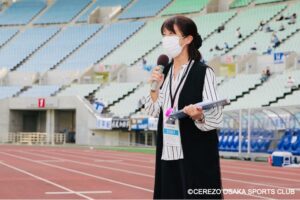A Visit to Nadeshiko’s Hometown Around Japan Episode 10. Cerezo Osaka Sakai Ladies
Sakai City in Osaka Prefecture can be reached by going west along the Yamato River flowing from the Nara Basin, where the ancient Japanese government “Yamato Chotei” was placed. Among the ancient tombs at the World Heritage site “Mozu-Furuichi Tumulus Clusters,” forty-four are in Sakai, with twenty-three of them registered as World Cultural Heritage monuments. Japan’s two largest keyhole-shaped mounded tombs, Nintoku-tenno-ryo Kofun and Richu-tenno-ryo Kofun, are thought to be built based on their appearance from the sea, as their direction is aligned with the coastline. In the old times of the Tumulus period, the city seems to have been an important spot, where massive burial mounds were constructed using past technologies of civil engineering.

Nintoku-Tenno-Ryo Kofun
Photo courtesy: Sakai City
Rapidly developed in the late Muromachi Period (1333 – 1573), the Port of Sakai became an international trade hub during medieval times, and left its name in history. The Old Sakai Lighthouse, one of the oldest wooden Western-style lighthouses and a nationally designated historical site, still remains quiet, overlooking the Osaka harbor.
On the edge of Chikko Yawatamachi, jutting out into the sea is the Sakai Municipal National Training Center for Soccer, nicknamed J-GREEN Sakai. Being a mecca for soccer in the Kansai region, this leading facility attracts a number of athletes and coaches. It contains 16 fields for soccer and 8 for futsal, one of the largest such in the country. The S1 Main Field, which can accommodate as many as 3,600 spectators, is the home of Cerezo Osaka Sakai Ladies.
This time, with a hint of sea breeze in the air, we visited J-GREEN Sakai and met two people with close ties to the team.

Sakai Municipal National Training Center for Soccer (J-GREEN Sakai)
Fan’s perspective connects citizens with the team
Yuri Matsumoto, Sports Department Director, Culture and Tourism Bureau, Sakai City Government
According to Yuri Matsumoto, who has been the director of the Sports Department of the city’s Culture and Tourism Department since last April, Sakai City has developed a ‘sports promotion plan’ aimed at providing citizens with a variety of lifetime sports opportunities. It also hopes to foster integrated sports clubs in local communities that will increase people’s accessibility to sports. Among the large facilities supporting the city’s promotion plan are Kura Sushi Stadium, Ohama Gymnasium and Budokan, and J-GREEN Sakai.
“People often use the nickname ‘J-GREEN Sakai,’ instead of Municipal National Training Center for Soccer, so I guess many don’t know this wonderful facility is operated by the city,” Matsumoto laughed.
Indeed, I didn’t know until recently, that the city owns this, one of the leading facilities in Japan.

Yuri Matsumoto, Director, Sports Department, Culture and Tourism Bureau, Sakai City
As we moved on to the topic of game watching, Matsumoto responded with excitement. “J League kicked off in my twenties. At that time, I often went to the Yammer Stadium Nagai, where Cerezo’s current president Hiroaki Morishima was playing. Today, I thought about bringing the toy I have at home of the mascot Roby for the interview,” she laughed. According to her, the most appealing aspect of the team is their youth. In 2021, the average age of starting members was sometimes under eighteen.
She witnessed their power from the stands, when they were playing against Iga FC Kunoichi Mie for the Section 20 game of 2021 Plenus Nadeshiko League Division 1.
“I was so pleased to see they were vigorous, young, and full of energy. Iga FC was in first place, but Miyuka Momono scored a goal in the first half, and Haruna Tabata in the second. I played back Tabata’s goal again and again on YouTube,” she said. “Momono was aggressive during the game, but turned up awkwardly for her postgame interview and said with a cute smile, ‘I’m happy to win thanks to so many supporters.’ It was so adorable and almost brought me to tears.” Matsumoto insisted difference between Momono as a player and her personality was also appealing, and made her an even bigger fan.
Having less athletic experience, Matsumoto admits her knowledge about sports is limited.
“During my work, I ask for help from colleagues who have played baseball or soccer. They teach me a lot about sports, but as an enthusiastic fan, I don’t think they can beat me easily,” she laughed.
Matsumoto hopes to continue her work by focusing not only on players, but also on spectators and women. Her idea, ‘sports is to be both played and watched,’ is sure to give more depth into the city’s sports culture.
What does the team mean to the city of Sakai?
“I wish to see as many citizens as possible coming to watch fun games at J-GREEN Sakai. And it would be nice if we open soccer schools, where local girls can meet with players and become motivated to follow them,” she answered. “The team could foster future world-class players, who would be welcome as they return home from abroad. That’s what I’d like to see. If we become capable of holding international competitions, the city will be a hot spot for tourists from around the world.” Matsumoto expects, along with the UNESCO World Heritage Mozu Furuichi Tumulus Clusters, that sports tourism will grow in the city.
Currently, the team has many talented players seeking to leap out into the world like their predecessors, Saori Takarada and Honoka Hayashi. I hope the day when the massive stadium of J-Green Sakai is filled with local audiences will come again.
Nadeshiko League has its own unique role
Ritsuko Wada
If you are a J League fan from the Kansai region, you probably know the name Ritsuko Wada. She has had multiple jobs including announcer, pitch-side reporter, and host of programs that support soccer teams. Currently a member of the executive committee at Kyoto Football Association as well as a referee instructor, she also works for the team as a stadium announcer. In her old days, while working as both an announcer and reporter, Wada attended soccer matches throughout Japan, blowing a whistle at competitions all over the country as a first-class female referee.
“I was jostled a number of times by Asako Takakura, the ex-manager of the national women’s team, Nadeshiko Japan, saying, ‘You’re in my way!’” laughed Wada. “She was clever enough to use my positioning during games to help maintain control, so I always tried to stay away from the ball, saying ‘Sorry!’ to her.” “We tended to stand close to each other, so I often called a foul against her,” she laughed.

Ritsuko Wada carrying out a pitch-side interview after a match
Wada’s most unforgettable match is one of the Section 22 of the 2014 Plenus Challenge League, when the team played against Fukuoka J Anclas. The team was desperate to win the game so as to get promoted to the Nadeshiko League’s newly organized Division 2 for the following year. At that time, the team mainly consisted of young-teen players. Their opponent, with superior physique, played not by exercising elaborate skills, but by focusing on long balls and headings, beating them 2-0.
“When I saw the girls struggling to get to their feet, chasing after the ball without complaining about calls, I thought, ‘I want to support this team from now on.’” The following year, Wada started to work as the team’s stadium announcer.
According to Wada, who has seen a fair amount of women’s games on the pitch, from the pitch side, or in the stands, from first glance, the team’s skill looks as if it’s “within your reach.”
“For children, their games are easy to understand and have a lot to learn from. The players’ level in the Nadeshiko League makes you believe you can reach the same, which I think is a great point. But in fact, their basic skills are far too high for us to reach,” she laughed.
2021 was a year of change for the team, as many promising players left to join clubs in the WE League for its first year.
“I think the Nadeshiko League has its own unique role, and it has already proved to be ‘as good as can be.’ Talking of Maika Hamano, who moved to INAC Kobe Leonessa in the middle of last season, she scored two goals during the opening round of the WE League. That gave her ex-teammates enough confidence to believe that they could become like her,” Wada said. “I want all the players in the Nadeshiko League to know that they are the driving force of women’s soccer in Japan. I hope the league will be one that girls yearn to join.”
Performances seen in the WE League clearly tell us why the Nadeshiko League is so important. By sending a number of players into the WE League, the team has just begun to turn a new page in their history.
This time, we visited Sakai City in Osaka Prefecture, the hometown of Cerezo Osaka Sakai Ladies.
Text by Kazuhiro Ishii






